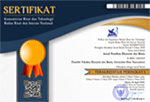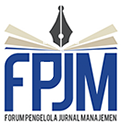Economic Pressure on the Interest Margin of Banks in Indonesia
Abstract
Net Interest Margin (NIM) is a profitability ratio to compare interest-based income and total assets owned. This study analyzes economic conditions on the Net Interest Margin (NIM) of conventional banking in Indonesia. This study uses the Vector Error Correction Model method with monthly data from 2008 to 2020. The long-term results are only inflation, which does not affect, while all variables do not affect the short-term. The Impulse Response Function results show that the exchange rate positively shocks the Net Interest Margin while interest rates, gold prices, oil prices, and inflation negatively shock NIM. The Forecast Error Variance Decomposition results found that inflation gave the second-largest variation while interest rates provided the minor variation.
Keywords:
VECM
Net Interest Margin
Interest Rates
Inflation
Exchange Rates
Gold Prices
Oil Prices
Full Text:
PDFReferences
Abdullateef, A. O., Muktar, S. S. M., Yusoff, R. Z., & Ahmad, I. S. B. (2014). Effects of Customer Relationship Management Strategy on Call Centre’s Employee Intention to Quit: Evidence from Malaysia Call Centers. Procedia - Social and Behavioral Sciences, 130, 305–315. https://doi.org/10.1016/j.sbspro.2014.04.036
Abor, J. Y., Agbloyor, E. K., & Kuipo, R. (2014). Bank Finance and Export Activities of Small and Medium Enterprises. Review of Development Finance, 4(2), 97–103. https://doi.org/10.1016/j.rdf.2014.05.004
Abuka, C., Alinda, R. K., Minoiu, C., Peydró, J. L., & Presbitero, A. F. (2019). Monetary Policy and Bank Lending in Developing Countries: Loan Applications, Rates, and Real Effects. Journal of Development Economics, 139, 185–202. https://doi.org/10.1016/j.jdeveco.2019.03.004
Amidu, M., & Wolfe, S. (2013). Does Bank Competition and Diversification Lead to Greater Stability? Evidence from Emerging Markets. Review of Development Finance, 3(3), 152–166. https://doi.org/10.1016/j.rdf.2013.08.002
Aviliani, Siregar, H., Maulana, T. N. A., & Hasanah, H. (2015). The Impact of Macroeconomic Conditions on The Banks Performance in Indonesia. Bulletin of Monetary Economics and Banking, 17(4), 379–402.
Brown, M., Guin, B., & Morkoetter, S. (2020). Deposit Withdrawals from Distressed Banks: Client Relationships Matter. Journal of Financial Stability, 46, 1–60. https://doi.org/10.1016/j.jfs.2019.100707
Dalnial, H., Kamaluddin, A., Sanusi, Z. M., & Khairuddin, K. S. (2014). Accountability in Financial Reporting: Detecting Fraudulent Firms. Procedia - Social and Behavioral Sciences, 145, 61–69. https://doi.org/10.1016/j.sbspro.2014.06.011
Dewi, G. A. P. I. L., & Triaryati, N. (2017). Pengaruh Faktor Internal Dan Eksternal Bank Terhadap Net Interest Margin Di Indonesia. Jurnal Manajemen UNUD, 6(6), 3051–3079.
Driver, C., Grosman, A., & Scaramozzino, P. (2020). Dividend Policy and Investor Pressure. Economic Modelling, 89, 559–576. https://doi.org/10.1016/j.econmod.2019.11.016
Ferry, R., & Wahyu, S. (2018). Calculation of Liquidity, Solvency, and Profitability Ratio in Manufacturing Company. Journal of Applied Accounting and Taxation, 3(2), 110–116.
Gayaker, S., Yalcin, Y., & Berument, M. H. (2020). The Day of the Week Effect and Interest Rates. Borsa Istanbul Review, 20(1), 55–63. https://doi.org/10.1016/j.bir.2019.07.010
Ghosh, A. (2016). Banking Sector Globalization and Bank Performance: A Comparative Analysis of Low-Income Countries with Emerging Markets and Advanced Economies. Review of Development Finance, 6(1), 58–70. https://doi.org/10.1016/j.rdf.2016.05.003
Gokmenoglu, K. K., & Fazlollahi, N. (2015). The Interactions among Gold, Oil, and Stock Market: Evidence from S&P500. Procedia Economics and Finance, 25, 478–488. https://doi.org/10.1016/s2212-5671(15)00760-1
Grundy, B. D., & Verwijmeren, P. (2020). The External Financing of Investment. Journal of Corporate Finance, 65, 1–47. https://doi.org/10.1016/j.jcorpfin.2020.101745
Hijazeen, I. (2017). The Determinants of Net Interest Margins in the Jordanian Commercial Banks. International Journal of Business and Social Science, 8(8), 27–37.
Hussain, I. (2014). Banking Industry Concentration and Net Interest Margins (NIMs) in Pakistan. Journal of Business Economics and Management, 15(2), 384–402. https://doi.org/10.3846/16111699.2012.732105
Idrisov, G., Kazakova, M., & Polbin, A. (2015). Oil Prices Impact on Economic Growth in Contemporary Russia: A theoretical Interpretation. Russian Journal of Economics, 1(3), 257–272. https://doi.org/10.1016/j.ruje.2015.12.004
Johansen, S., & Juselius, K. (1990). Maximum Likelihood Estimation and Inference on Cointegration--With Applications to the Demand for Money. Oxford Bulletin of Economics and Statistics, 52(2), 169–210.
Le, T. D., & Ngo, T. (2020). The Determinants of Bank Profitability: A Cross-Country Analysis. Central Bank Review, 20(2), 65–73. https://doi.org/10.1016/j.cbrev.2020.04.001
Liu, L. X., & Sathye, M. (2019). Bank Interest Rate Margin, Portfolio Composition, and Institutional Constraints. Journal of Risk and Financial Management, 12(121), 1–21. https://doi.org/10.3390/jrfm12030121
Nassar, K., Martinez, E., & Pineda, A. (2017). Determinants of Banks ’ Net Interest Margins in Honduras. Journal of Banking and Financial Economics, 1(7), 5–27. https://doi.org/10.7172/2353-6845.jbfe.2017.1.1
Nguyen, T. L. A. (2018). Diversification and Bank Efficiency in six ASEAN countries. Global Finance Journal, 37, 57–78. https://doi.org/10.1016/j.gfj.2018.04.004
Nugrahaning, S., & Wahyudi, S. (2016). Analisis Pengaruh NPL Dan LDR Terhadap NIM Dengan ROA Sebagai Intervening, Pengaruh NPL Terhadap NIM Dengan CAR Dan ROA Sebagai Intervening, Serta BOPO Terhadap NIM Bank Go Public Di Indonesia Periode 2011-2015. E-Jurnal Manajemen Universitas Diponegoro, 5(4), 2337–3792.
Ozili, P. K. (2018). Impact of Digital Finance on Financial Inclusion and Stability. Borsa Istanbul Review, 18(4), 329–340. https://doi.org/10.1016/j.bir.2017.12.003
Papavangjeli, M., & Leka, E. (2016). Micro and Macroeconomic Determinants of Net Interest Margin in the Albanian Banking System (2002-2014). Munich Personal RePEc Archive, 22(61), 1–36.
Ratti, R. A., & Vespignani, J. L. (2016). Oil Prices and Global Factor Macroeconomic Variables. Energy Economics, 59, 198–212. https://doi.org/10.1016/j.eneco.2016.06.002
Restianti, T., & Agustina, L. (2018). The Effect of Financial Ratios on Financial Distress Conditions in Sub Industrial Sector Company. Accounting Analysis Journal, 7(1), 25–33. https://doi.org/10.15294/aaj.v5i3.18996
Rita, P., Oliveira, T., & Farisa, A. (2019). The Impact of e-service Quality and Customer Satisfaction on Customer Behavior in Online Shopping. Heliyon, 5(10), 1–14. https://doi.org/10.1016/j.heliyon.2019.e02690
Roy, S., & Kemme, D. (2020). The Run-up to the Global Financial Crisis: A Longer Historical View of Financial Liberalization, Capital Inflows, and Asset Bubbles. International Review of Financial Analysis, 69, 1–53. https://doi.org/10.1016/j.irfa.2019.101377
Salman, A., & Nawaz, H. (2018). Islamic Financial System and Conventional Banking: A Comparison. Arab Economic and Business Journal, 13(2), 155–167. https://doi.org/10.1016/j.aebj.2018.09.003
Silva, M. O., & Lucinda, C. R. (2017). Switching Costs and the Extent of Potential Competition in Brazilian Banking. Economia, 18(1), 117–128. https://doi.org/10.1016/j.econ.2016.09.009
Sonaglio, C. M., Campos, A. C., & Braga, M. J. (2016). Effects of Interest and Exchange Rate Policies on Brazilian Exports. Economia, 17(1), 77–95. https://doi.org/10.1016/j.econ.2016.01.002
Sufian, F., Kamarudin, F., & Nassir, A. (2016). Determinants of Efficiency in The Malaysian Banking Sector: Does Bank Origins Matter? Intellectual Economics, 10(1), 38–54. https://doi.org/10.1016/j.intele.2016.04.002
Tan, Y. (2016). The Impacts of Risk and Competition on Bank Profitability in China. Journal of International Financial Markets, Institutions, and Money, 40, 85–110. https://doi.org/10.1016/j.intfin.2015.09.003
Thakor, A. V. (2020). Fintech and Banking: What Do We Know? Journal of Financial Intermediation, 41, 1–14. https://doi.org/10.1016/j.jfi.2019.100833
Tileag?, C., Ni?u, O., & Ni?u, C. V. (2013). Customer Relationships Management in Organizations. Procedia Economics and Finance, 6(13), 399–404. https://doi.org/10.1016/s2212-5671(13)00154-8
Wahyudi, I., & Sani, G. A. (2014). Interdependence Between Islamic Capital Market and Money Market: Evidence from Indonesia. Borsa Istanbul Review, 14(1), 32–47. https://doi.org/10.1016/j.bir.2013.11.001
Wasiaturrahma, Sukmana, R., Ajija, S. R., Salama, S. C. U., & Hudaifah, A. (2020). Financial Performance of Rural Banks in Indonesia: A two-stage DEA approach. Heliyon, 6(7), e04390. https://doi.org/10.1016/j.heliyon.2020.e04390
Were, M. (2015). Differential Effects of Trade on Economic Growth and Investment: A Cross-Country Empirical Investigation. Journal of African Trade, 2(1–2), 71. https://doi.org/10.1016/j.joat.2015.08.002
Were, M., & Wambua, J. (2014). What Factors Drive Interest Rate Spread of Commercial Banks? Empirical Evidence from Kenya. Review of Development Finance, 4(2), 73–82. https://doi.org/10.1016/j.rdf.2014.05.005
Werner, R. (2016). A Lost Century in Economics: Three Theories of Banking and the Conclusive Evidence. International Review of Financial Analysis, 46, 361–379. https://doi.org/10.1016/j.irfa.2015.08.014
Widyanto, D. A., Agung, R. E. W., & Alwiyah. (2020). Analisis Faktor-Faktor yang Mempengaruhi Net Interest Margin Pada Perusahaan Perbankan yang Terdaftar Di Bursa Efek Indonesia Periode 2012-2016. Maksimum Universitas Muhammadiyah Semarang, 10(2), 95–105.
Zeb, O., & Bashir, M. F. (2016). Bank Specific and Macroeconomic Determinants of Net Interest Margin: A Case of Selected Commercial Banks of Pakistan. International Journal of Economics and Empirical Research, 4(5), 220–228.
Zephaniah, C. O., Ogba, I. E., & Izogo, E. E. (2020). Examining the Effect of Customers’ Perception of Bank Marketing Communication on Customer Loyalty. Scientific African, 8, 4–11. https://doi.org/10.1016/j.sciaf.2020.e00383
DOI: https://doi.org/10.33633/jpeb.v7i1.4366
Article Metrics
Abstract view : 250 timesPDF - 178 times
DOI (PDF): https://doi.org/10.33633/jpeb.v7i1.4366.g2744
Refbacks
- There are currently no refbacks.
Jurnal Penelitian Ekonomi dan Bisnis (JPEB)
Published by
Fakultas Ekonomi dan Bisnis | Universitas Dian Nuswantoro
Jalan Nakula I No. 5-11, Semarang 50131, Indonesia
Email: udinusjpeb@gmail.com
Phone: (024) 3567010
Website: http://publikasi.dinus.ac.id/index.php/jpeb
ISSN
2442-5028 (Print)
2460-4291 (Online)

This work is licensed under a Creative Commons Attribution 4.0 International License.



.png)







